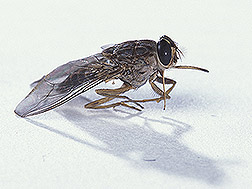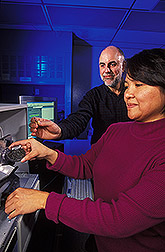"We knew NIR spectroscopy was useful for analyzing the protein inside grains, so I wondered if it couldn't detect developing insects, too," Baker says. He and Throne both work at the ARS Grain Marketing and ProductionResearchCenter in Manhattan, Kansas.
Back at the meeting, someone else-with a different set of research objectives-was listening to Throne's talk. But his interest wasn't in grains or their larval stowaways. Robert Wirtz, who heads the Entomological Branch of the Division of Parasitic Diseases at the Centers for Disease Control and Prevention (CDC) in Atlanta, Georgia, had his sights on another pest-one that leaves a more direct mark on human health and well-being.
Identifying Malaria Carriers
Wirtz wondered if the NIR-based technology could help identify mosquitoes infected with the malaria parasite. "Researchers used to have to dissect the insects," he says, "and remove and analyze the salivary glands to see whether they were infected." The ARS technology could possibly speed this critical identification process. He thought it might also be able to distinguish between different species of the genus Anopheles that carry the malaria-causing parasite. "There are species of Anopheles mosquitoes with different levels of significance in disease transmission," Wirtz explains. "We hoped the NIR technology could tell apart these look-alike species."
According to CDC entomologist Mark Benedict, another challenge is determining how old the mosquitoes are, since age plays an important role in disease transmission. "It takes time for mosquitoes to become infected," he says. "With older populations, there's more potential for transmission."
Floyd Dowell, ARS engineer and chief architect of the NIR sorting instrument, was able to find extra time to pursue this unexpected offshoot of his research. But now he would be working with living, breathing insects-instead of the usual, easy-to-handle kernels of grain. "Since adult insects are about the same size as kernels, we didn't have to change the design settings used by the instrument for measuring grains," he says. "But we did have to hand-place the insects into it." Then the instrument accurately identified the species of mosquito in just seconds.
Attempts to identify malaria-infected mosquitoes weren't as successful, but Wirtz says he hasn't given up on that possibility yet. "Our goal," he says, "is to use the technology being developed by ARS to someday determine the species, age, and infection status of mosquitoes. This would be a huge benefit for controlling malaria, West Nile virus, and other diseases transmitted by mosquitoes."
Energized by the mosquito work, Benedict and Wirtz wanted to see whether NIR could help distinguish between male and female pupae of the tsetse fly-an insect wreaking havoc in 37 countries in Africa. Coincidentally, a tsetse fly pupa is about the same size as a grain kernel and could be fed automatically through the NIR sorting system.
The tsetse fly carries the trypanosome parasite, which causes sleeping sickness in humans and nagana in livestock. Without medical treatment, sleeping sickness-or trypanosomiasis-is always fatal. According to the World Health Organization, more than 60 million people, mainly in rural and agricultural areas of afflicted African regions, are at risk.
Benedict thought NIR spectroscopy could help refine the sterile insect technique (SIT) that he was helping researchers with the United Nations Food and Agriculture Organization (FAO) and the International Atomic Energy Agency (IAEA) pursue to suppress tsetse fly numbers in ravaged parts of Africa.
We knew NIR spectroscopy was useful for analyzing the protein inside grains, so I wondered if it couldn't detect developing insects, too," Baker says. He and Throne both work at the ARS Grain Marketing and ProductionResearchCenter in Manhattan, Kansas.
Back at the meeting, someone else-with a different set of research objectives-was listening to Throne's talk. But his interest wasn't in grains or their larval stowaways. Robert Wirtz, who heads the Entomological Branch of the Division of Parasitic Diseases at the Centers for Disease Control and Prevention (CDC) in Atlanta, Georgia, had his sights on another pest-one that leaves a more direct mark on human health and well-being.
Identifying Malaria Carriers
Wirtz wondered if the NIR-based technology could help identify mosquitoes infected with the malaria parasite. "Researchers used to have to dissect the insects," he says, "and remove and analyze the salivary glands to see whether they were infected." The ARS technology could possibly speed this critical identification process. He thought it might also be able to distinguish between different species of the genus Anopheles that carry the malaria-causing parasite. "There are species of Anopheles mosquitoes with different levels of significance in disease transmission," Wirtz explains. "We hoped the NIR technology could tell apart these look-alike species."
According to CDC entomologist Mark Benedict, another challenge is determining how old the mosquitoes are, since age plays an important role in disease transmission. "It takes time for mosquitoes to become infected," he says. "With older populations, there's more potential for transmission."
Floyd Dowell, ARS engineer and chief architect of the NIR sorting instrument, was able to find extra time to pursue this unexpected offshoot of his research. But now he would be working with living, breathing insects-instead of the usual, easy-to-handle kernels of grain. "Since adult insects are about the same size as kernels, we didn't have to change the design settings used by the instrument for measuring grains," he says. "But we did have to hand-place the insects into it." Then the instrument accurately identified the species of mosquito in just seconds.
Attempts to identify malaria-infected mosquitoes weren't as successful, but Wirtz says he hasn't given up on that possibility yet. "Our goal," he says, "is to use the technology being developed by ARS to someday determine the species, age, and infection status of mosquitoes. This would be a huge benefit for controlling malaria, West Nile virus, and other diseases transmitted by mosquitoes."
Energized by the mosquito work, Benedict and Wirtz wanted to see whether NIR could help distinguish between male and female pupae of the tsetse fly-an insect wreaking havoc in 37 countries in Africa. Coincidentally, a tsetse fly pupa is about the same size as a grain kernel and could be fed automatically through the NIR sorting system.
The tsetse fly carries the trypanosome parasite, which causes sleeping sickness in humans and nagana in livestock. Without medical treatment, sleeping sickness-or trypanosomiasis-is always fatal. According to the World Health Organization, more than 60 million people, mainly in rural and agricultural areas of afflicted African regions, are at risk.
Benedict thought NIR spectroscopy could help refine the sterile insect technique (SIT) that he was helping researchers with the United Nations Food and Agriculture Organization (FAO) and the International Atomic Energy Agency (IAEA) pursue to suppress tsetse fly numbers in ravaged parts of Africa.
From Screwworms to Tsetse Flies
SIT was pioneered by another ARS entomologist, the late Edward F. Knipling, in the 1950s as an alternative to conventional pesticides. Often described as "birth control for insects," this approach knocks down problem insect populations by releasing large numbers of sterilized males, which behave and mate like other males, but aren't able to fertilize eggs. Over time and with continual releases, the targeted insect population dwindles and ultimately crashes. The technique was first used to rid North America of livestock-parasitizing screwworm flies.
But the SIT for tsetse needed a more rapid way to separate male and female flies. Males must be pulled aside to be irradiated, and females are needed to spawn future generations. Researchers also want to avoid accidentally mixing females with the males to be released, since females have a much greater potential to carry disease. "Initially, when telling the sexes apart, we had to look at every adult by hand after it emerged," says Benedict. "It was very time-consuming."
To gain access to thousands of tsetse fly pupae, Dowell traveled to Seibersdorf, Austria, in January 2004 to the FAO-IAEA Agriculture and Biotechnology Laboratory. He and the others wanted to see how soon in the insect's development NIR could distinguish between males and females. The earlier the better, as researchers need ample time to irradiate the males and transport them to strategic release sites. "We thought that we could tell them apart at 1 day before their emergence as adults-but probably not at 20 days before emergence, when the pupae are less developed," Dowell says. As it turned out, they could sex them best at 5 days before the pupae emerge as adults. At that point, the differences in reflected light, or spectra, of female and male pupae were most apparent.
"These differences might be explained by changes in cuticle thickness or by ovarian development in the females," Dowell speculates. "We can show without a doubt that there are differences between males and females, but unfortunately we lack the science to explain why. This will be a topic of future research if we can continue working in this area."
According to ARS scientists, the NIR technology may work better for tsetse fly sex separation than for its original, intended use in grains. FAO-IAEA has purchased an automated NIR sorting instrument and will begin routinely sorting tsetse fly pupae in 2005.
"This is exciting technology and has lots of potential impact in the grain industry and the field of entomology-in addition to the potential human impact, particularly in underdeveloped countries," says Dowell.-By Erin K. Peabody, Agricultural Research Service Information Staff.
"From Granaries to Insectaries: NIR Technology Helps Human Health" was published in the March 2005 issue of Agricultural Research magazine.
Form more information contact :
Dr. Floyd Dowell at floyd.dowell@ars.usda.gov or
Dr. James Throne at james.throne@ars.usda.gov





